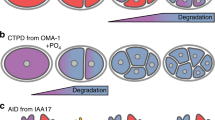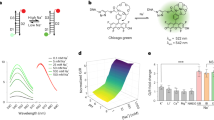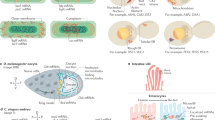Abstract
Nitric oxide synthase 3 (NOS3) produces the gasotransmitter nitric oxide (NO), which drives critical cellular signaling pathways by S-nitrosylating target proteins. Endogenous NOS3 resides at two distinct subcellular locations: the plasma membrane and the trans-Golgi network (TGN). However, NO generation arising from the activities of both these pools of NOS3 and its relative contribution to physiology or disease is not yet resolvable. We describe a fluorescent DNA-based probe technology, NOckout, that can be targeted either to the plasma membrane or the TGN, where it can quantitatively map the activities of endogenous NOS3 at these locations in live cells. We found that, although NOS3 at the Golgi is tenfold less active than at the plasma membrane, its activity is essential for the structural integrity of the Golgi. The newfound ability to spatially map NOS3 activity provides a platform to discover selective regulators of the distinct pools of NOS3.

This is a preview of subscription content, access via your institution
Access options
Access Nature and 54 other Nature Portfolio journals
Get Nature+, our best-value online-access subscription
$29.99 / 30 days
cancel any time
Subscribe to this journal
Receive 12 print issues and online access
$259.00 per year
only $21.58 per issue
Buy this article
- Purchase on Springer Link
- Instant access to full article PDF
Prices may be subject to local taxes which are calculated during checkout




Similar content being viewed by others
Data availability
The data that support the plots within this paper and other finding of this study are available from the corresponding author upon reasonable request.
References
Hess, D. T., Matsumoto, A., Kim, S.-O., Marshall, H. E. & Stamler, J. S. Protein S-nitrosylation: purview and parameters. Nat. Rev. Mol. Cell Biol. 6, 150–166 (2005).
Bredt, D. S. & Snyder, S. H. Nitric oxide: a physiologic messenger molecule. Annu. Rev. Biochem. 63, 175–195 (1994).
Lim, K.-H., Ancrile, B. B., Kashatus, D. F. & Counter, C. M. Tumour maintenance is mediated by eNOS. Nature 452, 646–649 (2008).
Xu, W., Liu, L. Z., Loizidou, M., Ahmed, M. & Charles, I. G. The role of nitric oxide in cancer. Cell Res. 12, 311–320 (2002).
Fukumura, D., Kashiwagi, S. & Jain, R. K. The role of nitric oxide in tumour progression. Nat. Rev. Cancer 6, 521–534 (2006).
Lahdenranta, J. et al. Endothelial nitric oxide synthase mediates lymphangiogenesis and lymphatic metastasis. Cancer Res. 69, 2801–2808 (2009).
Ying, L. & Hofseth, L. J. An emerging role for endothelial nitric oxide synthase in chronic inflammation and cancer. Cancer Res. 67, 1407–1410 (2007).
Thomsen, L. L. et al. Nitric oxide synthase activity in human breast cancer. Br. J. Cancer 72, 41–44 (1995).
Tschugguel, W. et al. Expression of inducible nitric oxide synthase in human breast cancer depends on tumor grade. Breast Cancer Res. Treat. 56, 145–151 (1999).
Martin, J. H., Begum, S., Alalami, O., Harrison, A. & Scott, K. W. Endothelial nitric oxide synthase: correlation with histologic grade, lymph node status and estrogen receptor expression in human breast cancer. Tumour Biol. 21, 90–97 (2000).
Choudhari, S. K., Chaudhary, M., Bagde, S., Gadbail, A. R. & Joshi, V. Nitric oxide and cancer: a review. World J. Surg. Oncol. 11, 118 (2013).
Sowa, G. et al. Trafficking of endothelial nitric-oxide synthase in living cells. Quantitative evidence supporting the role of palmitoylation as a kinetic trapping mechanism limiting membrane diffusion. J. Biol. Chem. 274, 22524–22531 (1999).
Sessa, W. C. et al. The Golgi association of endothelial nitric oxide synthase is necessary for the efficient synthesis of nitric oxide. J. Biol. Chem. 270, 17641–17644 (1995).
Zhang, Q. et al. Functional relevance of Golgi- and plasma membrane-localized endothelial NO synthase in reconstituted endothelial cells. Arterioscler. Thromb. Vasc. Biol. 26, 1015–1021 (2006).
Jin, Z.-G. Where is endothelial nitric oxide synthase more critical: plasma membrane or Golgi? Arterioscler. Thromb. Vasc. Biol. 26, 959–961 (2006).
Modi, S. et al. A DNA nanomachine that maps spatial and temporal pH changes inside living cells. Nat. Nanotechnol. 4, 325–330 (2009).
Surana, S., Bhat, J. M., Koushika, S. P. & Krishnan, Y. An autonomous DNA nanomachine maps spatiotemporal pH changes in a multicellular living organism. Nat. Commun. 2, 340 (2011).
Chakraborty, K., Leung, K. & Krishnan, Y. High lumenal chloride in the lysosome is critical for lysosome function. eLife 6, e28862 (2017).
Narayanaswamy, N. et al. A pH-correctable, DNA-based fluorescent reporter for organellar calcium. Nat. Methods 16, 95–102 (2019).
Leung, K., Chakraborty, K., Saminathan, A. & Krishnan, Y. A. DNA nanomachine chemically resolves lysosomes in live cells. Nat. Nanotechnol. 14, 176–183 (2019).
Thekkan, S. et al. A DNA-based fluorescent reporter maps HOCl production in the maturing phagosome. Nat. Chem. Biol. 15, 1165–1172 (2019).
Kojima, H. et al. Bioimaging of nitric oxide with fluorescent indicators based on the rhodamine chromophore. Anal. Chem. 73, 1967–1973 (2001).
Kojima, H. et al. Detection and imaging of nitric oxide with novel fluorescent indicators: diaminofluoresceins. Anal. Chem. 70, 2446–2453 (1998).
You, M. et al. DNA probes for monitoring dynamic and transient molecular encounters on live cell membranes. Nat. Nanotechnol. 12, 453–459 (2017).
Ferreira, C. S. M., Cheung, M. C., Missailidis, S., Bisland, S. & Gariépy, J. Phototoxic aptamers selectively enter and kill epithelial cancer cells. Nucleic Acids Res. 37, 866–876 (2009).
Yang, Y.-M., Huang, A., Kaley, G. & Sun, D. eNOS uncoupling and endothelial dysfunction in aged vessels. Am. J. Physiol. Heart Circ. Physiol. 297, H1829–H1836 (2009).
Lundberg, J. O., Weitzberg, E. & Gladwin, M. T. The nitrate-nitrite-nitric oxide pathway in physiology and therapeutics. Nat. Rev. Drug Discov. 7, 156–167 (2008).
Fulton, D., Gratton, J. P. & Sessa, W. C. Post-translational control of endothelial nitric oxide synthase: why isn’t calcium/calmodulin enough? J. Pharmacol. Exp. Ther. 299, 818–824 (2001).
Fulton, D. et al. Localization of endothelial nitric-oxide synthase phosphorylated on serine 1179 and nitric oxide in Golgi and plasma membrane defines the existence of two pools of active enzyme. J. Biol. Chem. 277, 4277–4284 (2002).
Goldstein, S., Russo, A. & Samuni, A. Reactions of PTIO and carboxy-PTIO with *NO, *NO2, and O2-*. J. Biol. Chem. 278, 50949–50955 (2003).
Fulton, D. et al. Regulation of endothelium-derived nitric oxide production by the protein kinase Akt. Nature 399, 597–601 (1999).
Veetil, A. T., Jani, M. S. & Krishnan, Y. Chemical control over membrane-initiated steroid signaling with a DNA nanocapsule. Proc. Natl Acad. Sci. USA 115, 9432–9437 (2018).
Fulton, D. et al. Targeting of endothelial nitric-oxide synthase to the cytoplasmic face of the Golgi complex or plasma membrane regulates Akt- versus calcium-dependent mechanisms for nitric oxide release. J. Biol. Chem. 279, 30349–30357 (2004).
Lytton, J., Westlin, M. & Hanley, M. R. Thapsigargin inhibits the sarcoplasmic or endoplasmic reticulum Ca-ATPase family of calcium pumps. J. Biol. Chem. 266, 17067–17071 (1991).
Namin, S. M., Nofallah, S., Joshi, M. S., Kavallieratos, K. & Tsoukias, N. M. Kinetic analysis of DAF-FM activation by NO: toward calibration of a NO-sensitive fluorescent dye. Nitric Oxide 28, 39–46 (2013).
Jiang, S. et al. Real-time electrical detection of nitric oxide in biological systems with sub-nanomolar sensitivity. Nat. Commun. 4, 2225 (2013).
Ramamurthi, A. & Lewis, R. S. Measurement and modeling of nitric oxide release rates for nitric oxide donors. Chem. Res. Toxicol. 10, 408–413 (1997).
Modi, S., Halder, S., Nizak, C. & Krishnan, Y. Recombinant antibody mediated delivery of organelle-specific DNA pH sensors along endocytic pathways. Nanoscale 6, 1144–1152 (2014).
García-Cardeña, G. et al. Dynamic activation of endothelial nitric oxide synthase by Hsp90. Nature 392, 821–824 (1998).
Farber-Katz, S. E. et al. DNA damage triggers Golgi dispersal via DNA-PK and GOLPH3. Cell 156, 413–427 (2014).
Lee, J. E. et al. Dependence of Golgi apparatus integrity on nitric oxide in vascular cells: implications in pulmonary arterial hypertension. Am. J. Physiol. Heart Circ. Physiol. 300, H1141–H1158 (2011).
Blake, R. A. et al. SU6656, a selective src family kinase inhibitor, used to probe growth factor signaling. Mol. Cell. Biol. 20, 9018–9027 (2000).
Skupien, A. et al. CD44 regulates dendrite morphogenesis through Src tyrosine kinase-dependent positioning of the Golgi. J. Cell Sci. 127, 5038–5051 (2014).
Ye, X., Rubakhin, S. S. & Sweedler, J. V. Detection of nitric oxide in single cells. Analyst 133, 423–433 (2008).
Lim, M. H., Xu, D. & Lippard, S. J. Visualization of nitric oxide in living cells by a copper-based fluorescent probe. Nat. Chem. Biol. 2, 375–380 (2006).
Eroglu, E. et al. Development of novel FP-based probes for live-cell imaging of nitric oxide dynamics. Nat. Commun. 7, 10623 (2016).
Vahora, H., Khan, M. A., Alalami, U. & Hussain, A. The potential role of nitric oxide in halting cancer progression through chemoprevention. J. Cancer Prev. 21, 1–12 (2016).
Ellefsen, K. L. & Parker, I. Dynamic Ca2+ imaging with a simplified lattice light-sheet microscope: A sideways view of subcellular Ca2+ puffs. Cell Calcium 71, 34–44 (2018).
Lee, P. C. et al. Impaired wound healing and angiogenesis in eNOS-deficient mice. Am. J. Physiol. 277, H1600–H1608 (1999).
Jani, M. S., Veetil, A. T. & Krishnan, Y. Precision immunomodulation with synthetic nucleic acid technologies. Nat. Rev. Mater. 4, 451–458 (2019).
Schindelin, J. et al. Fiji: an open-source platform for biological-image analysis. Nat. Methods 9, 676–682 (2012).
Maragos, C. M. et al. Nitric oxide/nucleophile complexes inhibit the in vitro proliferation of A375 melanoma cells via nitric oxide release. Cancer Res. 53, 564–568 (1993).
Awad, H. H. & Stanbury, D. M. Autoxidation of NO in aqueous solution. Int. J. Chem. Kinet. 25, 375–381 (1993).
Lewis, R. S. & Deen, W. M. Kinetics of the reaction of nitric oxide with oxygen in aqueous solutions. Chem. Res. Toxicol. 7, 568–574 (1994).
Brandes, R. P. & Janiszewski, M. Direct detection of reactive oxygen species ex vivo. Kidney Int. 67, 1662–1664 (2005).
Duarte, A. J. & da Silva, J. C. G. E. Reduced fluoresceinamine as a fluorescent sensor for nitric oxide. Sens. 10, 1661–1669 (2010).
Debacq-Chainiaux, F., Erusalimsky, J. D., Campisi, J. & Toussaint, O. Protocols to detect senescence-associated beta-galactosidase (SA-betagal) activity, a biomarker of senescent cells in culture and in vivo. Nat. Protoc. 4, 1798–1806 (2009).
Acknowledgements
We thank J. Kuriyan and W.C. Sessa for valuable discussions. We thank Y. Fang for technical discussions and for the reagents used in biochemical studies of NOS3. We thank the Integrated Light Microscopy facility and BioPhysics core facility at the University of Chicago. We thank M. Zajac for a critical reading of the manuscript. This work was supported by a research grant from the University of Pennsylvania Orphan Disease Center in partnership with the Andrew Coppola Foundation, the University of Chicago Women’s Board; a Pilot and Feasibility award from an NIDDK center grant no. P30DK42086 to the University of Chicago Digestive Diseases Research Core Center; the Chicago Biomedical Consortium, with support from the Searle Funds at The Chicago Community Trust, C-084; a Scientific Innovation Award from the Brain Research Foundation and the Mergel Funsky award to Y.K.
Author information
Authors and Affiliations
Contributions
M.S.J., A.T.V. and Y.K. designed studies. M.S.J., A.T.V. and J.Z. characterized the sensor. M.S.J. and A.T.V. performed imaging experiments. M.S.J. and J.Z performed quantitation of enzymatic rate. M.S.J. performed immunostaining and western blot based biochemical/cell biology assays. M.S.J., A.T.V., J.Z and Y.K. analyzed data. M.S.J. and Y.K. wrote the manuscript with input from all authors.
Corresponding author
Ethics declarations
Competing interests
The authors declare no competing interests.
Additional information
Publisher’s note Springer Nature remains neutral with regard to jurisdictional claims in published maps and institutional affiliations.
Supplementary information
Supplementary Information
Supplementary Tables 1 and 2, Figs. 1–23, synthetic procedures and Note
Supplementary Video 1
NOckoutPM reports real-time change in NO levels at the plasma membrane on treatment with ionomycin in combination with cholesterol (500 μM)
Supplementary Video 2
NOckoutPM reports real-time change in NO levels at the plasma membrane on treatment with thapsigargin (1 μM). NOckoutPM signal from T-47D cell pulsed with NOckoutPM and NOckoutTGN is represented as the ratio of DAR intensity to that of A488
Supplementary Video 3
NOckoutTGN reports real-time change in NO levels at the TGN on treatment with thapsigargin (1 μM). NOckoutTGN signal from T-47D cell pulsed with NOckoutPM and NOckoutTGN is represented as the ratio of DAR intensity to that of A647
Supplementary Video 4
Pharmacological NO scavenging in T-47D cells using Methylene blue (20 μM) leads to Golgi fragmentation
Rights and permissions
About this article
Cite this article
Jani, M.S., Zou, J., Veetil, A.T. et al. A DNA-based fluorescent probe maps NOS3 activity with subcellular spatial resolution. Nat Chem Biol 16, 660–666 (2020). https://doi.org/10.1038/s41589-020-0491-3
Received:
Revised:
Accepted:
Published:
Issue Date:
DOI: https://doi.org/10.1038/s41589-020-0491-3
This article is cited by
-
Detecting organelle-specific activity of potassium channels with a DNA nanodevice
Nature Biotechnology (2023)
-
Preparation, applications, and challenges of functional DNA nanomaterials
Nano Research (2023)
-
Nucleic acid-based fluorescent sensor systems: a review
Polymer Journal (2022)
-
Integrative network analysis interweaves the missing links in cardiomyopathy diseasome
Scientific Reports (2022)
-
A DNA-based voltmeter for organelles
Nature Nanotechnology (2021)



